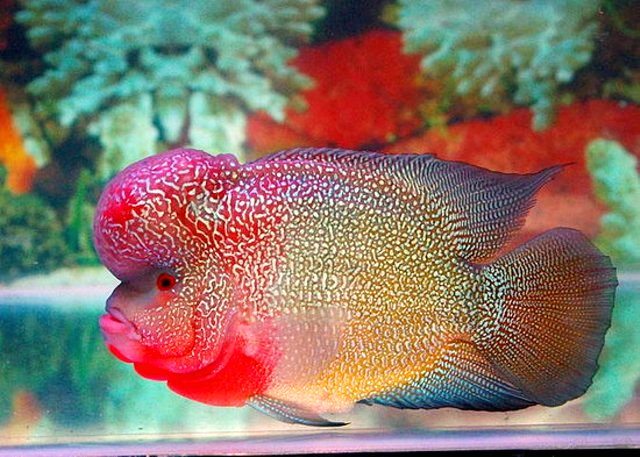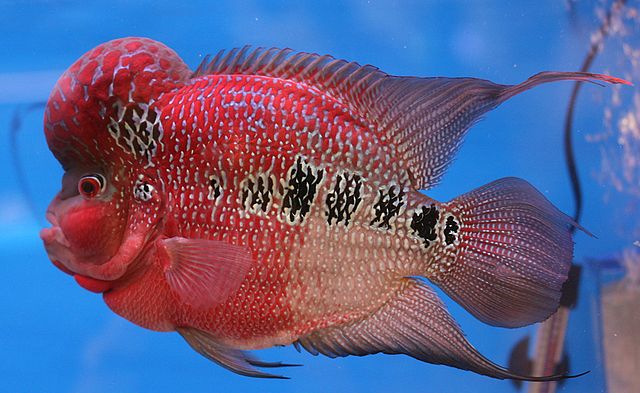The Flowerhorn Cichlid is a gorgeous fish breed that many people love to look at.
The easily-recognizable hump on their forehead, paired with their bright colours and interesting patterns, make them an attractive decision for an aquarium fish.

However, Flowerhorns are not the easiest pet to care for, and it’s important to know what you’re getting into if you decide to buy a Flowerhorn.
Here you can find all the important information on caring for Flowerhorn Cichlids.
Contents
Flowerhorn Cichlid Appearance & Personality
There’s much more to these beautiful fish than their colour scheme!
Size and Effort
Flowerhorns are a large fish; they frequently grow to 12-16 inches long (30-40 centimeters).
Juveniles will have colouring that can be significantly different from the colouring they’ll have at maturity, so if you’re going to buy a young Flowerhorn, keep in mind that its appearance will be radically changed with age.
If you want to know exactly the pattern your Flowerhorn will have, buy a mature adult that exhibits those patterns.
If you’re buying a mature fish, you will notice that some patterns and colours will go for exceedingly high prices, sometimes up to thousands of dollars!
These are generally fish that, in Chinese culture, are considered to bring good Feng Shui, and with it, good luck; there is generally no significant difference in expensive Flowerhorns aside from the pattern.

In general, Flowerhorns are a surprisingly hardy fish. They thrive in a wide range of conditions, and their diet is pretty normal for freshwater fish.
However, most people don’t suggest that beginners start with a Flowerhorn because they are extremely violent. Flowerhorns need at least a 55-gallon tank for a single fish, and will need substantially larger tanks if they have tankmates – often up to 200-gallon tanks.
The care needed to maintain such a large tank can be exhausting, so most beginners avoid them. However, it’s definitely not impossible for beginners to care for Flowerhorns if you’re very determined and willing to put in the effort.
Flowerhorns live for around 8-10 years, which is a pretty long time, but relatively average for large fish.
If you’re buying a mature Flowerhorn, you’ll want to ask the breeder how old it is so you have an idea of how much longer it will live in your aquarium.
Though Flowerhorns can be more expensive than other fish – sometimes significantly so, depending on the pattern and colouring – their long lifespan means you’re definitely getting your money’s worth.
Flowerhorns are mostly carnivorous. Not only will they attack and eat other fish, but they will even bite their owner’s hand if it is dipped into the aquarium while feeding!
It’s generally recommended not to keep two Flowerhorns in the same aquarium unless you have a very large tank, at least around 175 gallons, and you should not keep other species in a Flowerhorn environment.
Because of their serious violent nature toward each other, breeding Flowerhorns is something better left to the professionals.
Here’s a video showing the best tank-mates for your Flowerhorn Cichlid.
Flowerhorn Cichlids Care
As mentioned earlier, Flowerhorn Cichlids are generally hardy fish.
They can survive in a wide range of tank conditions, but there are specific conditions that are the best for them, which you can find here.

Tank Requirements
As with any other fish, you’ll want to set the aquarium up and run the filter for a while before introducing your Flowerhorn.
If you know someone with Flowerhorns and they’ll lend you one of their used filters, that can be helpful in jumpstarting good bacteria, but otherwise, just make sure it’s been running for at least a week.
Some people recommend running your filter for two weeks, but at least a week should be enough for your filter to have gotten used to the aquarium and be working properly.
Water Requirements
As mentioned earlier, Flowerhorns are generally very hardy fish. The conditions they’re most comfortable in vary widely, and it tends to be less difficult to maintain water conditions for Flowerhorns than some other freshwater fish.
Of course, make sure your water is dechlorinated – you can find water dechlorination kits at your local aquarium store, which you can use in addition to the traditional dechlorination technique of letting tap water stand out for more than 24 hours.
The temperature of the tank should stay between 80 and 89 degrees Fahrenheit (27 to 32 Celsius), which means you’ll likely need a water heater; be sure to have a thermometer mounted to your aquarium so you can monitor the temperature just in case.
The ideal pH for your water is 6.8 to 7.8, and the hardness range is between 9 and 20 dGH. Lighting should be the same as any other freshwater fish.
Tank Set-Up
One of the most important parts of any aquarium is the decorations! The decorations not only make the aquarium more pleasing to the eye, but also provide places for your Flowerhorn to hide and play.
The violence of Flowerhorns, however, means that typical aquarium decorations can be a bad choice. Live plants will likely be knocked over or ripped up, and smaller rocks will frequently be flipped over and moved, as Flowerhorns like to dig in the substrate.
The best way to decorate an aquarium for Flowerhorns is to add gravel substrate and some large rocks and wood that are too heavy for the Flowerhorn to knock over.
You can also add large fake plants to help with the aesthetic of your aquarium!
Tank Maintenance
As with many fish species, rapid temperature fluctuations should be avoided; make sure your temperature doesn’t fluctuate more than a few degrees Fahrenheit over the span of a few days.
If you’re using a tank heater, be sure to keep an eye on it, as malfunctions can be fatal to your Flowerhorn.
Water cleanliness is potentially more important for Flowerhorns than for other large fish. Flowerhorns produce a lot of refuse, which will raise the nitrite, nitrate, and ammonia levels in the water if not taken care of.
Ideally you should change about 30% of the water every week, and be sure to clean your tank with aquarium vacuums frequently.
Be careful though! Because of their violent nature, Flowerhorns are likely to bite you if you put your hand or arm in the tank while cleaning it.
Keeping Your Flowerhorns
Now that you have a properly set up aquarium, it’s time to add your Flowerhorns! There are a few tips and tricks to keeping the Flowerhorns safe and happy in their new environment, especially when they’re new.

Introducing the Flowerhorns to the Aquarium
Flowerhorns can generally be introduced to your aquarium just the same as any other freshwater fish.
Take the container or bag the Flowerhorn was sold to you in and gently float it in the aquarium for around 15 minutes. Then slowly remove water from the container and add water from your aquarium, changing a small amount every few minutes.
Once you judge the container to be around 90% new water, add the Flowerhorn properly. Leave it alone for at least a few hours so it can adjust to its new environment with no stress.
Feeding Your Flowerhorns
Flowerhorns, as mentioned before, eat almost entirely meat. The best diet for them is a mixture of specially-created Cichlid pellets and live or frozen prey.
As for live food, the best for Flowerhorns are bloodworms, krill, and earthworms. These should make up the majority of your Flowerhorn’s diet; they prefer live food to pellets, as their violent, carnivorous nature makes them a natural predator.
When you do feed it pellets, they should be high-quality and have at least a 45% protein content; make sure the pellets are made for Cichlid fish specifically so they will meet your Flowerhorn’s nutritional needs.
When you feed your Flowerhorns, feed them only what they can eat in a few minutes, and feed them two to three times a day.
Any food that is not eaten should be vacuumed up from the bottom of the tank in order to avoid polluting the water in a potentially-fatal way.
Sickness
As is frequent with hardy fish, Flowerhorns are unlikely to become sick if they have good care and their aquarium is well-maintained. However, sickness can still happen, and it’s important to have the information on hand just in case!
Ich is the most common sickness for freshwater fish and can readily affect Flowerhorns. Ich is easily recognizable by small, salt-like specks all over the body and fins, as well as loss of appetite.
If you notice these symptoms, turn your aquarium up to around 86 degrees Fahrenheit (30 degrees Celsius) for three days. If that doesn’t help, you may need to seek more professional help, such as an Ich medication treatment.
If your Flowerhorn contracts Ich, make sure you’re keeping them in a well-maintained aquarium; you may need to change the water more frequently or you may be overfeeding.
Flowerheads, like all other Cichlids, can have fungal and bacterial infections, as well as parasitic infestations. It’s important to read up on common tank diseases so you’re aware what to look out for with your Flowerhead.
In general, most of these diseases start with a more sluggish metabolism or odd physical changes, so if you note either of these things, it would be a good idea to research them; it’s better safe than sorry!

Flowerhorn Cichlids Conclusion
Flowerhorn Cichlids make interesting, colourful pets.
Though they do require a very large tank and significant upkeep, their hardy nature and bright patterns make them a possible fish even for beginners.
If you’re determined to keep a Flowerhorn and you’ve done the research and setup necessary, you can care for it even if you’ve never kept another fish!
Your dedication to keeping your Flowerhorn happy and safe is important, and with the right care and love, it can be a wonderful pet for years to come.
Do you own any Flowerhorn Cichlids?

